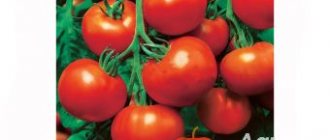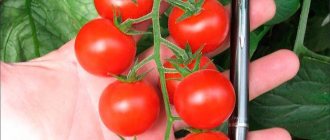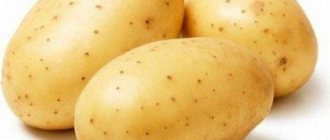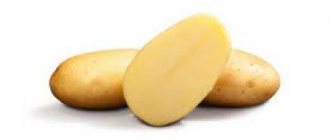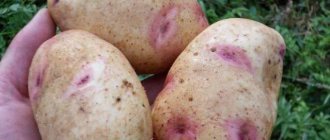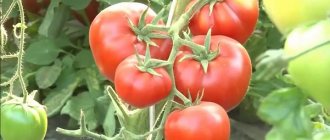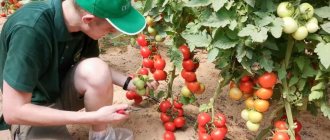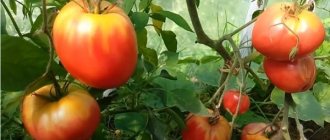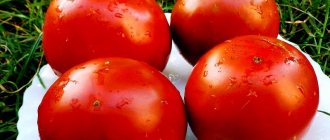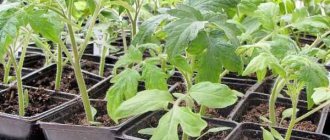History of variety development
This variety was developed by the Russian breeder N.P. Fursov, who works with the seed breeding company Partner. Work on developing a new variety was carried out at the beginning of this century. then an application was submitted to include the resulting tomato in the State Register of Russia. After several years of testing, the Tsar’s Temptation tomato was added to the State Register in 2021.
Photo of tomato Royal temptation F1
This tomato is recommended for cultivation in almost all regions of the country in open and closed ground.
This hybrid tomato is distributed by the Partner company (its other name is TK Leader).
Main stages of cultivation
The variety is grown only by seedlings and mainly in greenhouses. The starting point for drawing up a schedule for working with tomatoes is rooting the seedlings into the ground. This procedure is performed when the soil warms up to 15 C and the air temperature reaches 20 C.
As a result, an approximate schedule for the greenhouse method is as follows:
- laying seeds for germination - March 5;
- sowing of germinated seeds – March 10;
- shoots - March 15;
- planting seedlings in a greenhouse - May 10;
- end of June - first harvest.
For open ground, all deadlines are shifted 20 days later.
Germination of seeds
Hybrids cannot be grown from your own seeds. Purchased seeds from manufacturers have already undergone pre-sowing treatment and, in particular, do not require dressing.
Germinating seeds has two purposes:
- This is a germination test.
- Good stimulation of further plant development.
At the bottom of a small food container, place moistened gauze, folded in several layers. Seeds are laid out on it and the container is sealed with a lid to maintain moisture.
It is important that the seeds do not end up in water
Germination is carried out at room temperature and ends when the white sprouts are comparable in size to the seeds.
Sowing seeds for seedlings
For seedlings, you can use any purchased soil. Your garden soil harvested in the fall must first be disinfected by spilling it with a pink solution of potassium permanganate, and then dried.
To avoid further traumatic picking, sowing must be carried out immediately in separate small containers or cassettes. Seed placement depth is 1 cm.
Seedling care
Here 2 regular procedures are required:
- watering;
- turn the seedlings away from the light to avoid curvature of the sprouts.
Tomatoes, like all nightshades, begin to grow new roots if their stems are in the ground. An increase in the root system leads to proportional growth of the green part of the plant, and therefore to the development of the entire plant as a whole.
For this purpose, seedlings are transshipped. Young plants are transplanted into larger containers with the stem buried down to the lower leaves. This is done once during the growing of seedlings.
To do this you need:
- sow seeds in containers half filled with soil;
- after the shoots rise above the edge of the cups, they are completely covered with soil.
The same procedure is carried out when rooting seedlings in the ground.
The stem is buried to the lower leaves. If the seedlings are too tall, then the plants are buried obliquely (lying down).
Planting seedlings in the ground
Large indeterminate bushes of the Royal Temptation require space to grow. Therefore, planting density should not exceed 4 plants per square meter. This determines the planting pattern of 50x50 or 60x40 cm, depending on the format of the bed.
Planting care
The following procedures are regular:
- weeding;
- watering;
- loosening the soil after it dries;
- mulching;
- fertilizing
The last fertilizing with mineral fertilizers is carried out a month after planting the seedlings. In this case, nitrogen must be excluded from the complex. The main concern will be the stepson and garter.
In the south, the Royal temptation can be carried out in two stems. Only one should be left to the north. A larger number of ovaries will not have time to ripen before the cold weather.
Tomatoes Tsar's temptation: main characteristics and description of the variety
Tomato Royal temptation is an indeterminate hybrid,
Therefore, it is not recommended to collect seeds for further planting from fruits - the plants grown from them will not have positive parental qualities.
Indeterminate varieties of tomatoes have unlimited growth vigor, since in such plants it is not the inflorescence that grows at the top, but foliage.
Such tomato bushes always have excellent yields. However, in order to achieve this, it is necessary to provide the Royal Temptation tomato with some care.
If the bushes of this variety have enough lighting and heat, the shoots can grow up to 2.8-3.1 m (and sometimes higher)
. The stems are well leafy, the shape of the foliage is typical tomato, rich emerald color, with shortened internodes on the shoots.
Photo of tomato pulp Tsar's temptation
The first racemose inflorescence is formed above the 7-8 leaf; the resulting inflorescences are of a simple type. In each such inflorescence, up to 10 ovaries are formed, from which large tomatoes grow.
Each subsequent inflorescence is formed through 3 leaves. Therefore, ripening fruits have enough space for development.
This hybrid is classified as an early ripening variety.
– from the moment of seed germination to the harvesting of ripening fruits, 3.5 months pass.
Fruiting is extended over time, ripe fruits can be collected within 45-55 days
. It is unprofitable to grow this variety on an industrial scale, but the variety is ideal for small farms and summer cottages.
Description of the variety
Hybrid Royal Temptation belongs to the category of indeterminate, which is why its height is unlimited. The tomato is an early ripening plant; 100-105 days pass from the formation of mass shoots to the ripening of the first fruits.
The weight of tomatoes is average and is 120-130 g. The fruits have an elongated oblong shape, externally reminiscent of sweet peppers with a small nose. The peel of tomatoes is dense, initially green, and as the crop ripens, the color changes to bright red. There is no green spot near the stalk. Inside the tomato there are 2-3 seed chambers; there are relatively few seeds themselves.
Tomato bushes Royal Temptation are characterized by small internodes. The very first inflorescence is laid just above the 7-9 leaf. The sepals are oblong, and there is an articulation on the stalk. Each bunch consists of 7-9 tomatoes.
The variety stands out for its excellent taste and commercial qualities, as well as good transportability. The fruits are suitable for both fresh consumption and canning. Royal Temptation is a hybrid variety from the assortment. Bred by breeder Nikolai Petrovich Fursov.
Productivity
The hybrid is considered one of the most productive among all tomato varieties. From 1 square meter you can get up to 20 kg of fruit. With proper agricultural cultivation technology, productivity can become even higher.
Advantages and disadvantages
The positive properties of the hybrid Royal Temptation include:
- high resistance to major diseases;
- harmonious taste;
- rapid fruit ripening;
- fleshiness of tomatoes;
- productivity.
The variety has some negative characteristics:
- Garter required;
- weak growth in the north of the country;
- fruit cracking;
- deterioration of product and taste characteristics when grown in shady conditions.
Productivity
This hybrid tomato is recommended for growing in open and closed ground, but its yield is much higher in greenhouse conditions - up to 25 kg of ripe produce per square.
And the yield declared by the authors of the variety for garden beds can only be achieved when grown in the southern regions of Russia.
Usually, no more than 6-7.5 kg of ripe produce is harvested from each bush of this tomato per season, but in the middle zone the yield of this tomato in open ground is significantly reduced.
Due to a significant decrease in air temperature at night in this region, no more than 2.5 kg of tomatoes per plant can ripen in just one season.
This hybrid is highly resistant to adverse weather conditions and continues to grow, and its fruits ripen normally.
Growing
Planting seedlings
We recommend growing the variety in seedlings for high yield. We recommend starting work in the first ten days of March. When sowing with dry seeds, the first seedlings-loops should appear after a week. Seeds are sown in containers in a nutrient substrate, which, if necessary, can first be disinfected from pathogens of fungal and bacterial diseases with solutions of biofungicides.
Immediately after sowing, the containers can be covered with either a cap or transparent film and kept like that for the first seven days after planting in a warm room. After the first loops appear, you should move the containers with seedlings under bright light to prevent the seedlings from stretching. It is advisable, if possible, to harden the seedlings and gradually lower the room temperature to eighteen degrees. Seedlings need to be hardened off right before planting, ideally maintaining a temperature difference of five degrees between day and night.
At the end of April, you can plant seedlings in the greenhouse. If you grow tomatoes in open soil, you first need to check the soil temperature - it should not be lower than 15 degrees.
Top dressing
If the soil was not initially prepared and filled with loosening components and organic matter, then it is advisable to give the tomatoes additional fertilizing every two weeks. At the beginning of the growing season, fertilizers with a predominant nitrogen content, during the period from the beginning of flowering to the beginning of fruit ripening - with a predominant potassium content, then phosphorus-potassium fertilizers with the complete exclusion of nitrogen. At all stages of plant development, it is very good to fertilize the leaves with an aqueous solution of microelements.
Diseases and their prevention
This variety of tomatoes is not susceptible to fusarium, alternaria, nematode, tobacco mosaic and verticellosis. We recommend protecting the plant from late blight and gray rot. Standard fungicides will help preserve the harvest.
Productivity/Harvest/Storage Rules
Each tomato cluster bears up to nine fruits. With proper planting and care, you can harvest over 20 kg of tomatoes from one square meter of planting.
Fruits and taste
The fruits are pepper-shaped, reaching 130 g. The skin is quite dense and thin, the color of the tomatoes is bright scarlet. There are few seeds, a small yellow-green spot near the stalk. The tomato tastes well balanced, the consistency is fleshy without voids.
Advantages
The tomato hybrid Tsar's temptation has the following advantages:
- high productivity;
- the first fruits begin to ripen early, but fruiting is extended over time;
- the variety is resistant to many diseases that are characteristic of other vegetable plants and the nightshade family;
- good taste and good appearance of the fruit;
- the harvested crop has versatility of use;
- tomatoes can withstand long-distance transportation.
Tomatoes:
Tomato One Hundred Poods Tomato GIGALO Tomato Benito F1
Among the shortcomings, the following should be noted:
- Due to the large height of the shoots, they require a mandatory garter. It is also necessary to regularly remove stepchildren;
- if preventive measures are not taken, the Tsarskoye Temptation variety may be affected by blossom end rot;
- the seeds of this hybrid have a relatively high cost.
Advantages and disadvantages of the variety
One of the main advantages of the Royal Temptation tomato is its productivity. In favorable weather, you can actually harvest 12-15 kg of ripe tomatoes or even more from 1 m2. In addition, they have a good taste, which allows them to be used in a wide variety of dishes.
5-8 or more tomatoes are formed on one branch. Royal temptation
pros
- very pleasant sweet taste;
- high yield;
- early ripening;
- immunity to most Solanaceae diseases;
- good keeping quality;
- can be grown in any region of Russia (mainly in greenhouses);
- attractive presentation of tomatoes.
Minuses
- productivity largely depends on climatic conditions;
- bushes need gartering and pinching;
- weak immunity to blossom end rot;
- You won’t be able to grow it from your own seeds – you have to constantly buy it.
Landing
There is a high germination rate of seed material of this variety - up to 100%. But seeds do not always germinate evenly.
In most Russian regions, it is recommended to grow the Tsar's temptation in seedlings.
This hybrid is sown for seedlings in early March in purchased soil for vegetable plants. containers with planted seeds are covered with polyethylene and placed in a warm room. Lighting is not required during this period.
Photo of tomato seedlings Royal temptation
The first shoots may appear as early as the fourth day, but the bulk of the seed material germinates approximately 1.5 weeks after planting.
After the seed material has sprouted, the polyethylene is removed, and the containers are transferred to a well-lit place, and the temperature is lowered by 4-6 degrees so that the root system of the seedlings begins to actively grow.
When the seedlings have at least 2 true leaves, the thickened seedlings should be planted in separate cups. To prevent pinched plants from stretching and weakening, the temperature in the room should not be kept too high, and the seedlings should be provided with normal lighting for 12-14 hours a day.
THE BEST TOMATO FOR STUFFING! ROYAL TEMPTATION F1 – video
Seedlings of this hybrid are transplanted into greenhouses in late April - early May
. Plants should be moved into open ground when spring frosts have already ended - no earlier than the end of May.
The planting scheme for these bushes is no more than 4 plants per square.
Sowing seeds for seedlings
To obtain a large and high-quality harvest, purchased tomato seeds must be properly sown into seedlings, taking into account certain nuances.
Optimal timing
Typically, seedlings of early hybrids are recommended to be planted in a greenhouse on the 10th of April, so seeds are sown for seedlings in early March. To correctly calculate the time of sowing, it is necessary to take into account that seedlings appear within a week after sowing, the plant begins to bloom 55–60 days after sowing.
Soil mixture
To prepare the soil mixture, it is recommended to use 2 parts peat, 1 part garden soil, 1 part sand and 0.5 parts humus. Before using the soil mixture, it is first sifted and disinfected.
A double boiler is good for disinfection, as it allows you to kill almost all pathogenic bacteria and fungal spores, as well as weed seeds. Disinfection is carried out 10 days before using the soil so that beneficial bacteria appear in it. The finished soil is loose, has good air permeability and moisture holding capacity.
Important! To improve the breathability properties, crushed dried sphagnum moss is added to the steamed substrate.
Seedlings are grown in wooden boxes, individual plastic cups or peat pots (tablets). It is much more convenient to do this in a peat container, since each pot is then simply buried in the soil without first freeing the root system.
Plastic cups are also quite convenient to use, since they can be carefully cut and planted in the soil without destroying the earthen ball.
You must choose which container to use for sowing seeds yourself, based on your personal preferences and financial side. It is cheapest to use standard wooden boxes, which are available in any household; plastic cups are a little more expensive, but more convenient.
If you spend a little money and buy peat tablets or pots, the process of planting seedlings in a greenhouse is much simpler.
Seed preparation
As a rule, hybrid seeds sold are of sufficient quality, so there is no need to carry out special culling procedures. To obtain good seedlings, the seeds are pre-treated with disinfectants and growth stimulants.
A popular way to disinfect seeds is to treat the material with a 1% solution of potassium permanganate. To do this, pour a disinfectant solution into a glass jar and immerse the seeds in it for 20 minutes. After processing, the seeds should be thoroughly washed and dried.
To increase productivity and stimulate the growth of the above-ground part of the plant, it is recommended to treat the seeds with purchased products, such as Epin or Immunocytophyte. These products must be used in accordance with the instructions on the packaging.
After processing, the seeds should be dried by placing them on a paper towel for 1–2 days.
Important! There is no need to wash the seeds after treating them with growth stimulants.
Sowing seeds
It is recommended to sow tomato seeds as follows: fill the container with prepared soil, make small grooves up to 1 cm deep in it. Sow 2-3 seeds in separate containers, keeping a distance of 2 cm between them.
When sowing in a box, make long grooves every 4 cm, in which the seeds are laid out, maintaining an interval of 2-3 cm between them.
Seedling care
During the 1st week after sowing the seeds, the containers are covered with film or covered with a transparent cap. In this case, the room temperature should be maintained at about 25 ° C.
When you notice the first entrances, you need to remove the film and begin to create comfortable conditions for the seedlings. To do this, the room temperature is reduced to 18 °C, and the container is placed on the window to compensate for the lack of sunlight.
Daylight hours for tomato seedlings must last for 12 hours, so fluorescent lamps are used to organize additional lighting.
At first, when the seedlings are still very small, do not water them, but only spray them with a spray bottle to prevent poor development of the tomato root system. For spraying, use only boiled or settled warm water, about 20–25 °C.
Before the first full leaves appear, it is recommended to spray once a week. After 2-3 full-fledged leaves appear, the seedlings can begin to be watered at the root and make sure that water does not fall on the above-ground part of the plant.
10 days after the first true leaves appear, watering is carried out by adding light fertilizing to the water using complex fertilizers with a high nitrogen content. A nutrient solution is prepared based on potassium salt (1.5 g), urea (0.5 g) and superphosphate (4 g), dissolving the fertilizer in 1 liter of water. Water 2 times a week.
Hardening of seedlings
7 days after the emergence of seedlings, the seedlings begin to be hardened so that in the future they will react normally to temperature changes. To do this, the air temperature in the room must be reduced regularly: during the day from 25 to 18 °C, and at night - from 18 to 13 °C.
In addition, hardening is also carried out by ventilating the room, initially opening the window for 15 minutes and increasing the amount of time to 4 hours.
Seedlings are planted in open ground when the soil has already warmed up sufficiently (up to 15 °C), and the air temperature will remain at 20 °C during the day. If the area where the seedlings are planned to be planted is located in the southern region, the seedlings are planted in mid-May, if in the northern region - at the end of May.
Seedlings are planted in the greenhouse in mid-April.
The time for planting seedlings can be determined based on the external characteristics of the plant: height - 20-25 cm, stem thickness - 5-7 mm, number of leaves - 7-9. Each plant is planted at a distance of at least 60–70 cm from each other, maintaining a gap between rows of about 70–80 cm.
Further care
This tomato must be shaped in order to obtain good yields in the future. In the south, these bushes are formed into two stems, and in more northern regions only one stem is left, since the fruits on more shoots still will not have time to ripen.
In greenhouse conditions, you can also form a bush with 2 stems.
INTERESTING:
Iodine for tomatoes against late blight
When growing this variety, it is necessary to tie the stems to the trellises.
Watering is carried out regularly, but it should not be too abundant. After watering, it is necessary to apply a layer of mulch under each bush to prevent the rapid evaporation of moisture from the soil.
Straw, sawdust, and peat can be used as a mulching element. The mulch layer should be at least 3 cm.
Photo of a diagram for tying stems to trellises
How to care
Having planted seedlings in a permanent place of growth, it is necessary to take care of plant care, which will determine the quantity and quality of the harvest.
Tomatoes are one of the crops that do not tolerate both drought and severe waterlogging of the soil, so it is necessary to water the plants when the top layer of soil has dried out a little. In the absence of rain, water the tomatoes once a week, with water at room temperature at the root.
With regular precipitation, watering is reduced to once every 2–3 weeks.
Feeding
Feed tomatoes at least 3 times, but it is better to do this every 2 weeks. Fertilizers are used with a high content of nitrogen, phosphorus and potassium. Approximate composition of feeding: ammonium nitrate (15 g), superphosphate (50 g), potassium chloride (40 g) per 10 liters of water.
Also, once every 2 weeks they are fed with magnesium, and when the first flowers appear - with boron.
Stepsoning
Tomato planting is done to increase the yield of the bush. If the region is southern, then 2 shoots are left, on which the ovary will have time to ripen over a long warm period.
In the northern regions, only one central shoot is left, since the excess ovary on additional shoots, not having time to ripen before the first frost, will serve as unnecessary weight and take away the nutrients the plant needs.
All excess shoots that form on the main stem of the tomato must be removed in time by breaking them off with your hands. It is not necessary to break off the entire shoot, but to leave small “stumps” 5 cm in size: they will be an obstacle to the formation of new unnecessary shoots.
The first stepsons may appear on tomato seedlings even before they are planted in open ground, so it is recommended to remove them in a timely manner. The pinching procedure is usually carried out in the morning, when it is warm and sunny outside.
Important! If it’s cool and damp outside, you can’t plant tomatoes, as the plant can become infected through the wounds.
Soil care
The soil around the tomato bushes should be weeded regularly to remove weeds from the garden bed that interfere with the normal growth of the crop. Weeding should be carried out depending on the intensity and frequency of weed growth.
As necessary, weeds are removed by carefully pulling them out by the roots, trying not to damage the root system of the tomatoes.
It is necessary to loosen the soil after each watering - to restore normal aeration and penetration of nutrients during the process of fertilizing to the root system.
Also, experienced gardeners often resort to mulching so that moisture remains in the soil longer and tomatoes ripen faster. Straw, peat or sawdust are used as mulch. Mulch is laid out around each bush in a layer of 2–3 cm.
Feeding
During the season, you need to feed the Royal Temptation tomato according to the following scheme:
- a couple of weeks after transplanting the seedlings to a permanent place, they are fed with complex mineral fertilizer;
- during the period of budding and active formation of ovaries, fertilizing is applied to each bush, which contains boric acid (5 g per 5 liters of water) and calcium nitrate;
- During the period of fruit ripening, a solution of wood ash is added under the plants.
Features of cultivation
You need to grow the Marusya tomato in seedlings to get an early harvest. The seedlings need to be taken out and planted in a permanent place at the age of 55-60 days.
When grown in a greenhouse, sowing of tomatoes should be done in early March, and for open ground - in the second half of this month. For planting, you need to prepare wide containers 10 cm high, equipped with drainage holes. It is also necessary to prepare the substrate by combining the following components: turf, peat, sand and humus in a ratio of 2:1:1:1.
Algorithm of actions:
- Fill containers with soil mixture.
- Water generously and smooth out the top layer.
- Spread the seeds so that they do not touch each other.
- Sprinkle with a 0.5 cm layer of soil and moisten.
After planting, cover the bowls with film and place them in a dark place with a temperature not lower than + 25 ° C. After 6-7 days, when the seeds germinate, the containers should be moved to the windowsill and the temperature should be lowered to + 18 °C. After a week, the maintenance regime should be raised to + 20 °C. Picking seedlings should be done at the stage of 2-4 true leaves.
Marusya tomatoes should be planted in a permanent place in a greenhouse in the first half of May, and in unprotected soil - at the end of this month or at the beginning of June. Seedlings must be placed at the rate of 4 pcs. per 1 sq. m. When replanting, deepen the plants to the first pair of leaves, which will allow the formation of a powerful root system.
Important! It is impossible to keep seedlings at home, as this negatively affects further growth.
Caring for tomatoes of this variety does not involve complex actions. The variety tolerates drought well. Therefore, watering should be carried out only when the top layer of soil is completely dry. To prevent excessive evaporation in the greenhouse, the soil at the base of the bushes should be mulched with humus or peat.
Tomatoes should be fertilized three times. The first time during the growth of green mass. During this period, you can use organic matter, and in its absence, urea or calcium nitrate at the rate of 30 g per bucket of water. The bushes need to be fertilized the second and third time during fruit set and ripening. During this period, superphosphate (30 g) and potassium sulfate (15 g) should be used per 10 liters of water.
To increase the yield of Marusya tomatoes, it is necessary to remove the stepsons in a timely manner. And to preserve the presentation of the crop, the bushes should be tied to a support as the main shoot grows.
Tomatoes Tsar's temptation: reviews of those who planted
Oksana, 40 years old, Ryazan: A salesperson in a specialized store persuaded me to buy the seeds of this hybrid. She grew the variety using the seedling method and cared for the seedlings according to all the rules. At the beginning of May, I transplanted strong, healthy seedlings into a greenhouse, where the bushes began to grow quickly. When the shoots reached a height of 1 m, I began tying them to trellises, forming each bush into 2 stems. She fed and watered strictly according to the schedule. As a result, I collected 7.5 kg of ripe fruits from each plant. Some were used for food, the rest were pickled.
Lena, 50 years old, Ulyanovsk region: I planted the Tsar’s Temptation tomato last year for the first time. I would like to note that this variety is quite unpretentious, but to obtain a high yield it requires fertilizing several times a season. But the bushes require regular removal of stepsons and mandatory tying up. Another advantage of this hybrid is its high resistance to disease, so you don’t have to deal with the consequences of disease.
The hybrid Tsar's Temptation, despite its comparative “youth,” is already becoming popular among summer residents and farmers, since it has good yields, and the variety can be grown not only in open ground, but also in greenhouse conditions.
High resistance to diseases and good taste of ripe fruits are also undeniable advantages of this hybrid.
Characteristics of tomato Marusya
This crop variety, like other types, has strengths and weaknesses. Therefore, when choosing it, you need to study them in advance, which will allow you to appreciate it, as well as understand what difficulties may arise during cultivation.
Marusya tomato yield and fruiting
The Marusya tomato is characterized by stable fruiting, and the crop ripens on time even in rainy and cool summers. The variety is not affected by temperature changes. Flower pollen remains productive during abnormal heat.
The yield of the variety per bush is 1.5-1.8 kg in open ground, and 2 kg in a greenhouse. To increase efficiency, it is necessary to remove the stepsons as they grow, which allows the plant’s forces to be redirected to the formation of the ovary.
Important! Productivity per 1 sq. m of tomato Marusya can reach 8 kg if all rules of agricultural technology are observed.. In the southern regions of the country, tomatoes of this variety ripen at the end of July, and in the central and northern regions - at the beginning of August
In the southern regions of the country, tomatoes of this variety ripen at the end of July, and in the central and northern regions - at the beginning of August.
Area of application of fruits
Marusya is a variety of universal use. Its tomatoes are suitable for fresh consumption, as well as for preparing summer salads with herbs. Tomatoes are also suitable for whole-fruit canning, pickling and drying.
The harvested crop can be used to prepare:
- ketchup;
- sauce;
- pastes;
- juice
Important! During heat treatment, the skin of Marusya tomatoes does not crack, the flesh will retain its structure.
Resistance to diseases and pests
Tests of the variety have shown that the Marusya tomato is immune to temperature changes and prolonged rains. Based on this, it was found that this variety does not suffer from fusarium and verticillium blight, and also exhibits average resistance to late blight.
It is also little susceptible to pests. Only slugs with high air humidity can harm bushes and fruits.
Features of cultivation
The time for sowing seeds for seedlings is the first ten days of March. For seedlings, prepare a special soil consisting of a mixture of humus and turf soil. The looseness of the soil will ensure the addition of sand. The soil can become a source of infection of seedlings; in order to prevent the disease, it must be disinfected. Treatment with a solution of potassium permanganate or heating in the oven is used. Seeds are also subject to dressing. They are placed in a fabric bag and dipped in a fungicide solution for 20-30 minutes.
Containers for seedlings are boxes, plastic containers, cups, and peat pots. The choice is given to gardeners. After planting in moist soil, the container is covered with film. Greenhouse conditions accelerate seed germination. If the seedlings are grown in a common box, then with the appearance of two true leaves, picking is carried out. Prepare a well-lit place for seedlings, otherwise the stems will stretch. The growing process takes almost 2 months, during which time the seedlings are fed 2 times and regular watering is provided.
When choosing a location, you should give preference to a well-lit area. The soil must be pre-filled with complex mineral fertilizers. Bushes are planted at a rate of no more than 3 plants per 1 square meter. m. When forming, it is recommended to leave 2 stems. It is necessary to regularly pinch the side shoots, it is advisable to remove the lower leaves. The stems need to be tied to stakes. Setting a huge number of fruits requires additional nutrition. During the growing season, 3 feedings are carried out. Watering and loosening of the soil are carried out regularly.
Royal Temptation F1. Results
Hello! During the competition, I did not write about agricultural technology for growing tomatoes. I’ll write now. Maybe it will be useful to someone, maybe someone will scold it. But nonetheless. The sowing of the hybrid seeds was carried out, as always, on International Women's Day, March 8. We usually sow in plastic boxes, and that’s what happened this year as well. We have long come to the conclusion that the best soil is a mixture of Terra Vita and Magic Bed soils. After mixing, sift this mixture through a sieve with 5*5 mm cells. We filled the box with prepared soil to 5 cm, made 1 cm grooves with a ruler, sowed the seeds, sprinkled with earth. Then we added 4 tablets of Glyokladin, buried them in the soil and watered them with settled snow water. The box was covered with film and placed in a warm place where it was about 25 degrees. The first shoots appeared after 5 days. Shoots March 17 With pepper Rastyushki March 18 Before picking After picking Picking was done in 330 and 550 ml pots with the same soil. Somewhere in there is the Royal Temptation Lighting with fluorescent lamps and LED lamps with a temperature of 6500 K April 5 April 5 After picking the tomatoes were watered with a fertilizer composition based on “Rich House”. April 12 On April 12, all the tomatoes were transferred to the greenhouse under the greenhouse installed there. Covered with spandbond. At the time of the move, the tomatoes were fed with Master fertilizer 18.18.18 The greenhouse was covered with film several times, there was a sharp drop in temperature. A greenhouse in a greenhouse on May 8, there is a Royal Temptation. All tomatoes were planted on April 29! They planted them in ordinary soil, dug a hole, and poured it with a solution of Fitosporin Olympic at the rate of 1 tbsp. l per bucket of water. When planting, OMU Tomatoes were used, at the rate of 1 tbsp. a spoonful of fertilizer per hole. After May 8, no photographs were taken, but I can say that all the tomatoes in the greenhouse were watered the same way, 1.5 liters, every other day. Subsequently, watering was carried out in 1.5 - 2.5 liters, as needed. During the growing season May-June the following was produced: 1. Fertilizing with mineral fertilizer Kristalon Scarlet. 20 grams per 10 liters. 1 liter each.2. Fertilizing with phosphorus-potassium fertilizer Potassium Monophosphate. 20 grams per 10 liters. 1 liter each.3. Spraying with Boron and Calcium chelate. Brexil Ca4. Spraying with calcium nitrate. 5. Loosening the tree trunk circle with the addition of ash, like fertilizer. No other fertilizing was done. The tomatoes were watered with warm water using drip irrigation, as needed. The garter was made using a PE rope and, if necessary, using plastic clamps. The tomatoes were collected for canning. Publication (collection 07/21 and 08/16) Royal Temptation F1 Publication (September 17) Royal Temptation F1. Last harvest of ripe tomatoesPublication (September 21) Royal Temptation F1. Last harvest I’ll say right away that tomatoes are suitable not only for whole-fruit canning, but also for drying, processing and fresh consumption. The salad from the hybrid Tsar's Temptation is very good. Results: Bush 1 Root 2.5 Flowers. The tomato could continue to set and bear fruit Bush 2 Root when planted “lying down” 2.7 Also blooms Bush 3 Excellent root system 3 meters Blooms Stepson blooms New root stepson with color From the extracted plants it can be judged that the hybrid is suitable for all types of country greenhouses and open ground, when grown on a trellis. The overall result was: 1 bush - 6502 grams. 2 bush - 6067 grams. 3 bush - 7255 grams. The total result for growing 3 tomato plants was 19,824 grams, which corresponds to the manufacturer’s assurance, when growing 3.5-4 plants per square meter. Tasting: Medium fruit, about 110-120 g. Sealed on a plate with salt
The taste is good - excellent! Recommendations and experience. It is very important to maintain this hybrid in two, and with organic-mineral nutrition, in three stems. The hybrid is resistant to blossom end rot. The hybrid does not crack at normal levels of watering. I recommend using 1 potassium fertilizing during the growing season ( extract from ash) It is imperative to remove all unnecessary stepchildren. Good luck to you!
